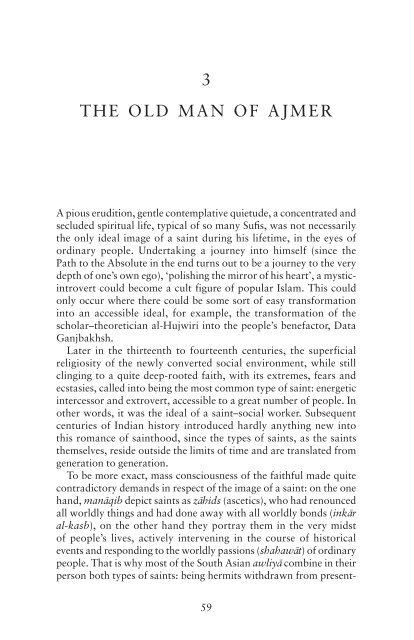Muslim Saints of South Asia: The eleventh to ... - blog blog blog
Muslim Saints of South Asia: The eleventh to ... - blog blog blog
Muslim Saints of South Asia: The eleventh to ... - blog blog blog
You also want an ePaper? Increase the reach of your titles
YUMPU automatically turns print PDFs into web optimized ePapers that Google loves.
3<br />
THE OLD MAN OF AJMER<br />
A pious erudition, gentle contemplative quietude, a concentrated and<br />
secluded spiritual life, typical <strong>of</strong> so many Sufis, was not necessarily<br />
the only ideal image <strong>of</strong> a saint during his lifetime, in the eyes <strong>of</strong><br />
ordinary people. Undertaking a journey in<strong>to</strong> himself (since the<br />
Path <strong>to</strong> the Absolute in the end turns out <strong>to</strong> be a journey <strong>to</strong> the very<br />
depth <strong>of</strong> one’s own ego), ‘polishing the mirror <strong>of</strong> his heart’, a mysticintrovert<br />
could become a cult figure <strong>of</strong> popular Islam. This could<br />
only occur where there could be some sort <strong>of</strong> easy transformation<br />
in<strong>to</strong> an accessible ideal, for example, the transformation <strong>of</strong> the<br />
scholar–theoretician al-Hujwiri in<strong>to</strong> the people’s benefac<strong>to</strong>r, Data<br />
Ganjbakhsh.<br />
Later in the thirteenth <strong>to</strong> fourteenth centuries, the superficial<br />
religiosity <strong>of</strong> the newly converted social environment, while still<br />
clinging <strong>to</strong> a quite deep-rooted faith, with its extremes, fears and<br />
ecstasies, called in<strong>to</strong> being the most common type <strong>of</strong> saint: energetic<br />
intercessor and extrovert, accessible <strong>to</strong> a great number <strong>of</strong> people. In<br />
other words, it was the ideal <strong>of</strong> a saint–social worker. Subsequent<br />
centuries <strong>of</strong> Indian his<strong>to</strong>ry introduced hardly anything new in<strong>to</strong><br />
this romance <strong>of</strong> sainthood, since the types <strong>of</strong> saints, as the saints<br />
themselves, reside outside the limits <strong>of</strong> time and are translated from<br />
generation <strong>to</strong> generation.<br />
To be more exact, mass consciousness <strong>of</strong> the faithful made quite<br />
contradic<strong>to</strong>ry demands in respect <strong>of</strong> the image <strong>of</strong> a saint: on the one<br />
hand, manāqib depict saints as zāhids (ascetics), who had renounced<br />
all worldly things and had done away with all worldly bonds (inkār<br />
al-kasb), on the other hand they portray them in the very midst<br />
<strong>of</strong> people’s lives, actively intervening in the course <strong>of</strong> his<strong>to</strong>rical<br />
events and responding <strong>to</strong> the worldly passions (shahawāt) <strong>of</strong> ordinary<br />
people. That is why most <strong>of</strong> the <strong>South</strong> <strong>Asia</strong>n awliyā combine in their<br />
person both types <strong>of</strong> saints: being hermits withdrawn from present-<br />
59


